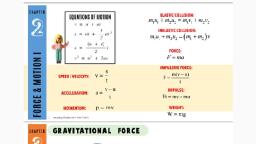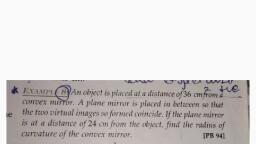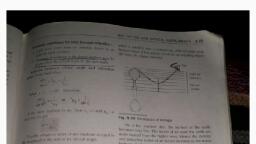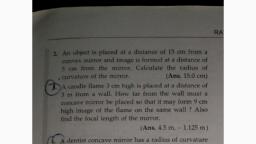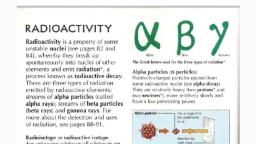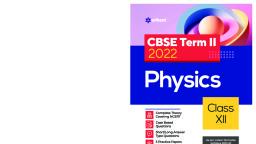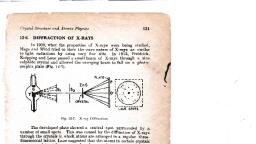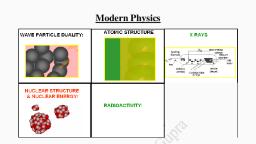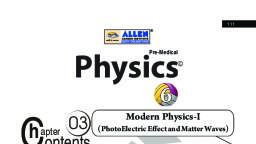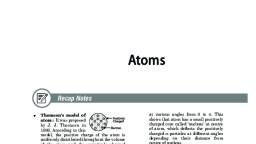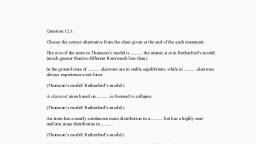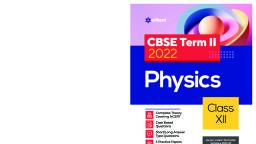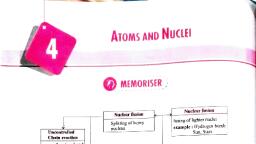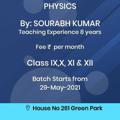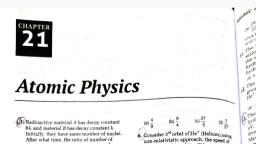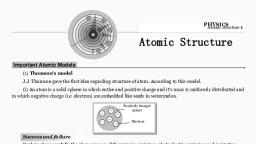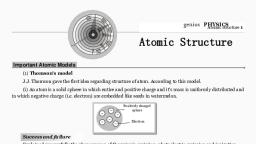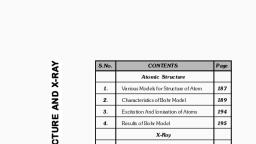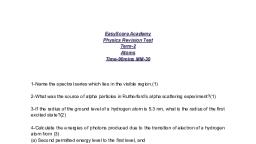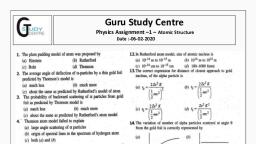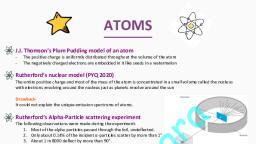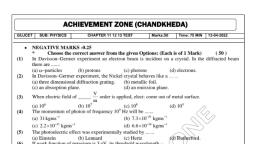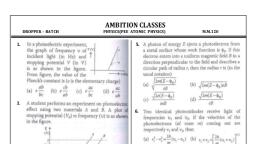Page 1 :
JEE-Physics, ATOMIC STRUCTURE, , VARIOUS MODELS FOR STRUCTURE OF ATOM, , . Dalton's Theory, Every material is composed of minute particles known as atom. Atom Is indivisible i.e. it cannot be subdivided., It can neither be created nor be destroyed. All atoms of same element are identical physically as well as, chemically, whereas atoms of different elements are different in properties. The atoms of different elements are, made up of hydrogen atoms. (The radius of the heaviest atom is about 10 times that of hydrogen atom and its, mass is about 250 times that of hydrogen). The atom is stable and electrically neutral, , : Thomson's Atom Model, The atom as a whole is electrically neutral because the positive charge present on the atom (sphere) is equal to, the negative charge of electrons present in the sphere. Atom is a positively charged sphere of radius 10°” m, in which electrons are embedded in between. The positive charge and the whole mass of the atom is uniformly, distributed throughout the sphere., , electron, , eS, , Se, eS 26 positively, eo, , matter, , : Shortcomings of Thomson's model, {i The spectrum of atoms cannot be explained with the help of this model, (i) Scattering of @-particles cannot be explained with the help of this model, , RUTHERFORD ATOM MODEL, , . Rutherford experiments on scattering of a — particles by thin gold foil, , The experimental arrangement ts shown in figure. a-particles ore emitted by some radioactive material (polonium),, kept inside @ thick lead box. A very fine beam of a-particles passes through a small hole in the lead screen. This, well collimated beam is then allowed to fall on a thin gold foil. While passing through the gold foil, a~particles, are scattered through different angles. A zine sulphide screen was placed out the other side of the gold foil. This, screen was movable, so as to receive the G-particles, scattered from the gok foil at angles varying from 0 to, 180. When an a-particle strikes the screen, it produces a flash of light and it is observed by the microscope. It, was found that :, , , , , , 8, NB) « cosec’, No) >, , , , , , , , , , , , , , , , about 1 in S000 is same are cevintec! 90 190, repelled back thraugh kage argle 6 oo
Page 2 :
JEE-Physics, , Most of the a — particles went straight through the gold foil and produced flashes on the screen as if there, were nothing inside gold foil. Thus the atom is hollow., , Few particles collided with the atoms of the foil which have scattered or deflected through considerable krge, angles, Few particles even turned back towards source itself,, , The entire positive charge and almost whole mass of the atom is concentrated in small centre called a nucleus., The electrons could not deflected the path of a a ~ particles i.e. electrons are very light., , Electrons revolve round the nucleus in circular orbits. So, Rutherford 1911, proposed a new type of model, of the atom. According to this model, the positive charge of the atom, instead of being uniformly distributed, throughout a sphere of atomic dimension is concentrated in a very small volume (Less than 10°"m is, diameter) at it centre. This central core, now called nucleus, is surrounded by clouds of electron makes,, The entire atom electrically neutral. According to Rutherford scattering formula, the number of a ~ particle, , N, nt(2Ze*)* 1, scattered at an angle @ by a target are given by Nagar aT, fo z, , Where N, = — number of a — particles that strike the unit area of the scatter, a = Number of target atom per m?, t = Thickness of target, Ze = Charge on the target nuclous, 2e = Charge on a - particle, r = Distance of the screen from target, y, = Velocity of a — particles at nearer distance of approach the size of a, , °, nucleus or the distance of nearer approach is given by, , 1 (22e)'___ 1 (226)", , , , , , , , arn © xb", , Bohr's Atomic Modal, , In 1913 Neils Bohr, a Danish Physicist, introduced a revolutionary concept i.e., the quantum concept to explain the, stability of an atom. He made a simple but boll statement that "The old classical laws which are applicable to bigger, bodies cannot be directly applied to the sub-atomic particles such as electrons or protons., , Bohr incorporated the following new ideas now regarded as postulates of Bohr’s theory., 1. The centripetal force required for an encircling electron is provided by the electrostatic attraction between the, , nucleus and the electron i.e. axe, YF, , m, v, r, z, , 1, , , , = Absolute permittivity of free space = 8.85 10°? C? N' m*, = Mass of electron, , = Velocity (linear) of electron, , = Radius of the orbit in which electron is revolving., , = Atomic number of hydrogen like atom.
Page 3 :
JEE-Physics, Electrons can revolve only in those orbits in which angular momentum of electron about nucleus is an integral, " h nh, multiple of 2x’ he., mvr Qn oli), , n = Principal quantum number of the orbit in which electron is revolving., , Electrons in an atom can revolve only in discrete circular orbits called stationary enorgy levels (shells). An, electron in a shell is characterised by a definite energy, angular momentum and orbit number, While in any of, these orbits, an electron does not radiate energy although it is accelerated., , Electrons in outer orbits have greater energy than those in inner orbits. The orbiting electron emits energy when, it jumps from an outer orbit (higher energy states) to an inner orbit (ower energy states) and also absorbs energy, when it jumps from an inner orbit to an outer orbit. E,- E_ = hv, E, , where, E, = Outer energy state, E_ = Inner energy state, Vi ™ Frequency of radiation, , , , The energy absorbed or released is ahvays in the form of electromagnetic radiations. Nuc», , MATHEMATICAL ANALYSIS OF BOHR'S THEORY, , 5: 6 te, et oh, From above equation (i) and (i) ie., Fee FT and mur = 5 i, , We get the following results,, , Velocity of alectron in nth orbit : By putting the value of mvr in equation (i) from (ii) we get, 1 nh z[_* ]_z, gee - (4) «Z| -¢ |Z, 4ne, Oa ee 2e,h ne Ait, , (1.6x10")°, , aps, ee Yo Fy BBS x10 ~ 6.625210 ™, , c, - ple, 2.189 10° ms’ Ta7 22 10° m/s, , where ¢ = 3 10" m/s = speed of light in vacuum, , Radius of the nth orbit : From equation (iii), putting the value of v in equation (ii), we get, , , , a(2. a = Zee i, , Z@) oh wf eh | _ nt, n 26h)" 2r Z| sme", , 8.85 10°" «(6.625 <10™)", , ar Os. 10m, "3.14 «9.11 x10 «(1.6 x10") =0.53A, , where
Page 4 :
JEE-Physics, , 3. Total energy of electron in n* orbit :, , , , 2, From equation @) KE=2mu? =—“°— ond pec—t_(ele)_ see = spel e 2 KE, 2 Sxe,r 4x, or, , -Ze*, Sxe,r, , , , Total energy of the system E = KE + PE = -2KE + KE = - KE =, , . +) gt, By putting the valie of r from the equation (iv), we get e=X{- me‘) _2, , en} eae EL), a san a, , -(9.11 10") (1.6 «10"”)", , So _, « -13.6, 8 (8,85 x10") «(6.625 x10), , where E, =, , 2nr, , 4. Time period of revolution of electron in nth orbit : ae, , n (42h) _ nt, By putting the values of rand v, from (ii) and (i) T =x) =} = —.T,, Zz \ne ) 2, , 4 «(8.85 x10)" «(6.625 x10)", where, Ty =———_—_—_—_+—_—-= 1.51 10° secand, 9.11 «10 «(1,6 «10""), , 5. Frequency of revolution in nth orbit :, , 1 2 met 2? 9.1110" «(1.6 x10)", , e786 10 He, 4 (8.85 «10") (6.625 10), , , , # af ale where, ¥ is called wave number,, my fe, , R_=R,, = Rydberg constant, , 9.11107" «(1.6 «10")', , 1.097 10" m= 1,097 10° A” (for stationary nucleus)., 8 x(8.85 x 10°") (6.625 x10)" «3 «10°, , If nucleus is not stationary (1.¢., mass of nucleus is not much greater than the mass of the revolving particle ike, , electron), then R = where, m = mass of revolving particle and M = mass of nucleus, , l+m/M
Page 5 :
JEE-Physics, , SPECTRAL SERIES OF HYDROGEN ATOM, , It has been shown that the energy of the outer orbit is greater than the energy of the inner ones. When the Hydrogen, atom is subjected to external energy, the electron jumps from lower energy state i.e. hydrogen atom is excited., The excited state is unstable hence the electron return to its ground state in about 10% sec, The excess of energy is, now radiated in the form of radiations of different wavelength. The different wavelength constitute spectral series., Which are characteristic of atom emitting, then the wave length of different members of series can be found from the, following relations, , , , This relation explains the complete spectrum of hydrogen. A detailed account of the important radiations are listed below,, , . Lyman Series : The series consist of wavelength which are emitted when electron jumps from an outer orbits, to the first orbit i. ¢., the electronic jumps to K orbit give rise to lyman series. Here n, * 1 & n, » 2, 3, 4, a, The wavelengths of different members of Lyman series are :, , , , , , . First mamber | In this case n, = 1 and n, = 2 hance t= n{ 2-2) -SE, = act = t= 4 - 1216 10” m= 126A, 3R 3 «10.97 «10°, ‘ 1 Fs:, . Second member : In this case n, = 1 and n, ~ 3 hence 7 =R)s5-3r, 9 9 ., = ke > k= ————— = 1026 10 m =1026A, 3R 8x 10.97 «10°, Similarly the wavelength of the other members can be calculated., . Limiting members «In his cate 0, = Land n=» hence $= 8[ L-—L] =, , => asd = 4-1 _- 912 10%m ~ 912A, , R 10.97 «10°, This series lies in ultraviolet region., , . Balmer Series : This series is consist of all wave lengths which are emitted when an electron jumps from an, outer orbit to the second orbit i, e., the electron pimps to L orbit give rise to Balmer series., Here n, = 2 and n, ~ 3, 4, 5 ......... The wavelength of different members of Balmer series., , . 1_,[1_1]_5R, + First member ; I ths cen, = 2 and a, = 3, hence = R| 3--t] = SE, = a=26 = ,-—36___ ~ 6663 10°%m = 6563A, BR 5=10.97=10, , - Second member - In this cave 9, ~ 2 and n, =4, tence B= [Ht] = 3, 16, , “Suo7mion 10'"m = 48614, «10.97 x, , saet& oy, 3R, , ° Limiting members: inthis ase n, = Zand a, = 9, bance = R|p-2]= 2 => a= 3 ~ 366A, o, , This series lies in visible and near ultraviolet region,
